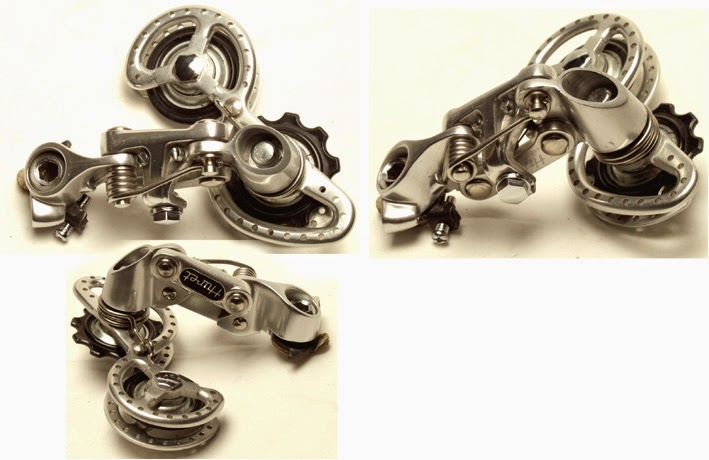So why am I posting a picture of an 8 year old girl?
Well, she looks really cute on that bike. But she is relevant to this blog. Better yet, she has something in common with it.
What?, you ask.
Midlife Cycling turns 8 years old today. I wrote my first post on 2 June 2010. I'm still "at it," 2567 posts later. And I'll keep it up as long as I enjoy it. Since I've never stopped loving cycling or writing, I don't think I'll lose the pleasure I've found in this blog and you, my audience.
So what has changed? Writers are the worst judges of their own work, but I'm guessing that this blog has developed a "voice", whatever it may be. In the beginning, I was probably making some effort to imitate other bike blogs I'd read, especially ones written by women. (I'm thinking particularly of Lovely Bicycle.) But I am a very different sort of woman, and cyclist, so I realized that I could do no more or less than follow my own instincts and inclinations. Sometimes I write about my own trips or bikes; other times I write about other people's rides and machines; still other times I veer into topics that don't have much of a relationship to cycling. Others will judge the results, but I am happy to be writing this blog and that others are reading it.
Aside from the blog itself, some other things in my life have changed since I started. For one thing, I now have four bikes I didn't have back then: Dee-Lilah, my new Mercian Vincitore Special; Vera, the twin-tube Miss Mercian mixte I bought about a year after I started this blog; Josephine, the Trek 412 estate-sale find and Martie, the Fuji Allegro that's become my commuter/errand bike. And I no longer have Helene, the Miss Mercian I bought not long after I started this blog, and the two Schwinn LeTours I acquired and used as commuter/errand bikes.
Oh, and I now have one cat, Marlee, who wasn't even born when I wrote that first post. Sadly, Charlie and Max, my feline buddies back then, are gone.
On a happier note: I have taken, in addition to hundreds of day rides, trips abroad which have included cycling: Prague, Paris (twice), Italy (Rome and Florence) and Montreal. And I've been to Florida a number of times to visit my parents but also to enjoy some warm-weather riding in the middle of winter.
I don't know what changes and adventures lie ahead. All I know is that you'll read about them here!
 |
| From Thanks, Mail Carrier |
Well, she looks really cute on that bike. But she is relevant to this blog. Better yet, she has something in common with it.
What?, you ask.
Midlife Cycling turns 8 years old today. I wrote my first post on 2 June 2010. I'm still "at it," 2567 posts later. And I'll keep it up as long as I enjoy it. Since I've never stopped loving cycling or writing, I don't think I'll lose the pleasure I've found in this blog and you, my audience.
So what has changed? Writers are the worst judges of their own work, but I'm guessing that this blog has developed a "voice", whatever it may be. In the beginning, I was probably making some effort to imitate other bike blogs I'd read, especially ones written by women. (I'm thinking particularly of Lovely Bicycle.) But I am a very different sort of woman, and cyclist, so I realized that I could do no more or less than follow my own instincts and inclinations. Sometimes I write about my own trips or bikes; other times I write about other people's rides and machines; still other times I veer into topics that don't have much of a relationship to cycling. Others will judge the results, but I am happy to be writing this blog and that others are reading it.
Aside from the blog itself, some other things in my life have changed since I started. For one thing, I now have four bikes I didn't have back then: Dee-Lilah, my new Mercian Vincitore Special; Vera, the twin-tube Miss Mercian mixte I bought about a year after I started this blog; Josephine, the Trek 412 estate-sale find and Martie, the Fuji Allegro that's become my commuter/errand bike. And I no longer have Helene, the Miss Mercian I bought not long after I started this blog, and the two Schwinn LeTours I acquired and used as commuter/errand bikes.
Oh, and I now have one cat, Marlee, who wasn't even born when I wrote that first post. Sadly, Charlie and Max, my feline buddies back then, are gone.
On a happier note: I have taken, in addition to hundreds of day rides, trips abroad which have included cycling: Prague, Paris (twice), Italy (Rome and Florence) and Montreal. And I've been to Florida a number of times to visit my parents but also to enjoy some warm-weather riding in the middle of winter.
I don't know what changes and adventures lie ahead. All I know is that you'll read about them here!





-filtered.jpg)

